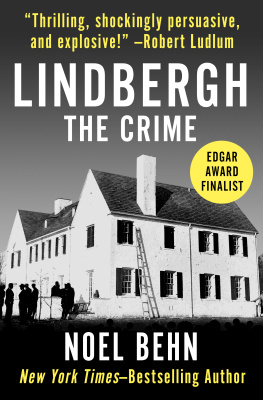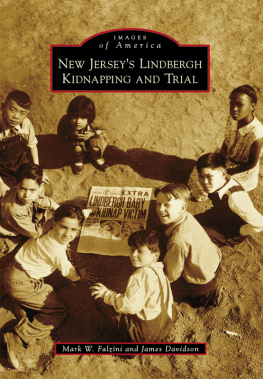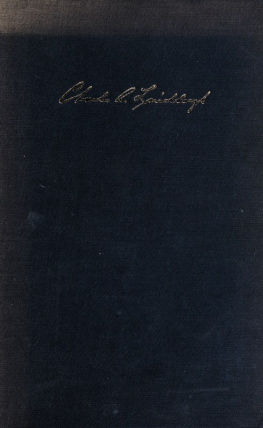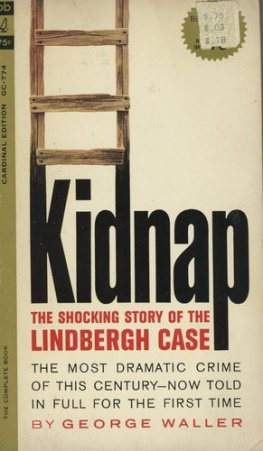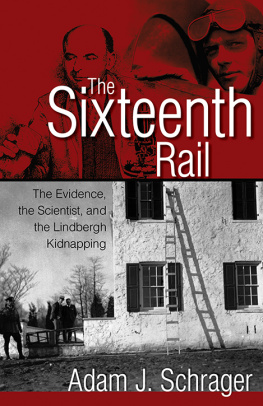Lindbergh
The Crime
Noel Behn

Moth to Flame
Celebrated crime, steeped in the warp of passing decades, can become more fiction than fact. Small matter that the illicit act went unsolved or was duly prosecuted and punished; partisans emerge to champion lore regarding its commission. This is the stuff from which legends are spawned, not to mention culture and entertainment. Fresh data need not be unearthed to set theorists of a certain offensesay, the John F. Kennedy assassinationat the throats of counter-theorists.
I, for one, become shamelessly intrigued by the discovery of new information concerning almost any classic American case, which is what occurred on a sunny April morning in 1986. The material contained in a black wooden box that was resting on my literary agents table dealt with the most infamous perpetration in this countrys history: the 1932 kidnapping-killing of twenty-month-old Charles Lindbergh, Jr. One document in particular, I was assured, named the true slayer of the childand it was not the person who had been convicted of the crime and died in the electric chair.
The black box measured two and a half feet by two feet by one and a half feet and had been discovered hidden away between two rafters in the attic of a house on Belgrove Drive, Kearny, New Jersey. The owners of the residence took the find to their lawyer, who brought it to the executor of the estate of the homes previous owner, Doris A. Pelletreau. Doris had died on October 6, 1976. Her husband, Jesse William Pelletreau, had passed away on December 3, 1958, and there was no doubt that the contents of the black box belonged to him. What to do with the material was solved when an independent television-commercial maker learned of its existence. She teamed with a pair of prestigious play and movie producers. The documents were purchasedand now rested on my agents desk, where I had my first look at them.
Bill Pelletreau, I soon learned, was a private investigator who had been called into the Lindbergh kidnapping case in late 1934 by the attorney for a thirty-five-year-old illegal German alien named Bruno Richard Hauptmann. Hauptmann, a carpenter living with his wife and baby son in the Bronx, was being held at the Bronx County jail, charged with extorting ransom money from Lindbergh. At the time Pelletreau joined the case, New Jersey officials were trying to have Hauptmann extradited so they could try him for the murder and kidnapping of the child, crimes the German avidly denied committing.
The kidnapping had occurred some two and a half years earlier, on March 1, 1932, at the rural Lindbergh estate near tiny Hopewell, New Jersey. A series of twelve written messages demanding ransom were received before money was paid. A thirteenth message, which said where the child could be found, alive and healthy, proved a lie. The missing infants corpse was discovered in a shallow grave within earshot of the family home. It was estimated he had been dead since the night of his disappearance.
The first marked bill from the ransom appeared two days after the payment was made. Ransom currency continued to surface, mainly in the New York City area, for two and a half years, until September of 1934, when Hauptmann was picked up for passing a ten-dollar note. Another small-denomination bill from the ransom was found on his person; several more were recovered at his home. They were gold-certificate currency that had been taken out of circulation over a year earlier. Hauptmann confessed to having horded gold notes and spending several with full knowledge that to do so was illegala minor and common offense in America.
Bruno Richard Hauptmann not only lived near the Bronx cemetery where one moonless night back in 1932 a Lindbergh intermediary had paid fifty thousand dollars in ransom to a supposed member of the kidnapping gang named John, but the German carpenter also resembled artists sketches of John. However, there had been no reliable eyewitness who could place Hauptmann or anyone else near the Lindbergh home at the time of the kidnapping. The After subjecting Hauptmann to a foolproof test, the police departments handwriting experts were certain the immigrant carpenter had not authored the thirteen ransom messages received by Lindbergh and his designees.
The New York Police Department was in favor of releasing Hauptmann; the New Jersey State Police, which had jurisdiction if the kidnapping-murder ever went to trial, wanted him held longer. Law officers, dismantling Hauptmanns garage, discovered another fourteen thousand dollars in ransom loot. The gaunt, lanky carpenter shifted his story. Now he claimed the money had been left by a friend who had returned to Germany and since diedleft in a shoe box that Hauptmann had stored on an upper shelf in a kitchen closet and forgotten. A recent rainstorm caused a ceiling leak that inundated the closet. Not until taking down and opening the wet shoe box had Hauptmann discovered what it containedfourteen thousand dollars. Because the dear departed friend owed Hauptmann approximately seven thousand dollars, Bruno appropriated that amount for himself and left the rest for the dead mans relatives. To safe-keep the money, he devised a series of hiding places in the garage. The dead friends name was Isador Fisch. No one bought what became known as the Fisch story.
After being held incommunicado for thirty-six hours and with still nothing to link him to the actual kidnapping-murder, Dick Hauptmann, as he preferred to be called, was finally arrestedfor the crime of extortionand remanded to the Bronx County jail at the Bronx County Courthouse. A relative of his German-born wife, Anna, contacted a Brooklyn lawyer, James M. Fawcett, who agreed to defend him. Though the Bronx grand jury indicted Hauptmann for extorting ransom money from Charles A. Lindbergh, Fawcett realized the real legal battle would occur over New Jerseys well-publicized intent to extradite Hauptmann and try him for the murder of Charles Lindbergh, Jr., in the county where the death had allegedly occurred.
Private detective Bill Pelletreau was one of several handwriting specialists engaged by Fawcett to prove that Hauptmann had not written the ransom messages. As the defense attorney suspected would happen, the Bronx DA bowed to New Jerseys request for an extradition hearing at the Bronx courthouse. Fawcett was ready, or at least thought so. He had records and witnesses to prove that Hauptmann had been at work as a carpenter in New York City the day of the kidnapping; he had other witnesses to establish Bruno was with them in the Bronx that night. The employment records disappeared along with the employment witnesses. Alibi witnesses for the night either couldnt be found or informed the defense lawyer they were afraid to testify. The presentation by New Jerseys fiery attorney general was dramatic and persuasive. So was Charles A. Lindberghs presence in the courtroom. Bill Pelletreau never testified as to his handwriting findings. Hauptmann was extradited to New Jersey in October of 1934 to await prosecution for the kidnapping and murder of Charles Lindbergh, Jr. James M. Fawcett was replaced as his lawyer. Pelletreau was also let go.
The trial of the century began January 2, 1935. The proceedings took thirty-two-days and ended on Wednesday, February 13, with the jury finding Hauptmann guilty of murdering Charles Lindbergh, Jr. The judge sentenced him to die in the electric chair. A round of appeals began that would last more than a year.
Back in April of 1933, President Franklin Delano Roosevelt, as part of his policy to remove the depression-racked United States from its monetary gold standard, proscribed the private ownership of gold bullion, gold coins, and gold-certificate currency. Since a majority of bills in the ransom payment were gold certificates, the list of their serial numbers was reissued to banks and businesses. On May 1, 1933, more than a year before Hauptmann would be apprehended, the final day for the turn-in, $2,980 in ransom-loot notes was exchanged for legal currency at the New York City branch of the Federal Reserve Bank. The teller handling the transaction could not recall who had deposited the listed bills but believed it was a man. The signature on the deposit slip was J. J. Faulkner; the address he wrote in, 537 West 149th Street, New York. No one by that name could be found on West 149th Street, or anywhere else. The $2,980 deposit and photographs of Faulkners signature made world headlines. One year and five months later, with Hauptmann in custody and awaiting extradition to New Jersey to stand trial for the kidnapping-murder, experts who had sworn under oath that Bruno was the author of the ransom messages also conceded that the J. J. Faulkner signature had not been written by him. William Pelletreau went further. He found that key letters, especially the

